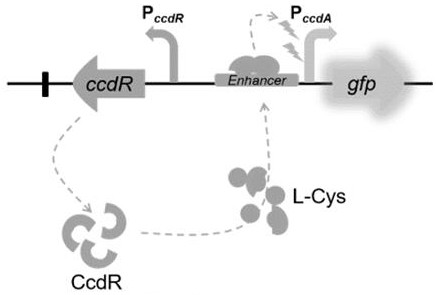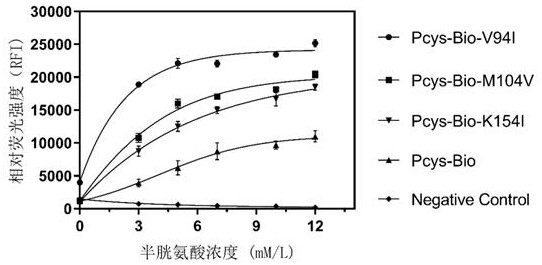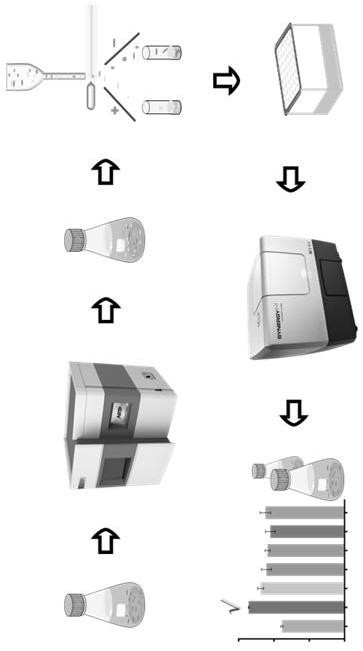L-cysteine biosensor and application thereof
A biosensor, cysteine technology, applied in the direction of application, microbes, and microbe-based methods, etc., can solve the problems of rapid screening and isolation of L-cysteine high-yielding strains
- Summary
- Abstract
- Description
- Claims
- Application Information
AI Technical Summary
Problems solved by technology
Method used
Image
Examples
Embodiment 1
[0019] Embodiment 1: Construction of L-cysteine biosensor plasmid
[0020] In this example, the biological elements of each component in the L-cysteine biosensor were amplified by PCR method, and assembled by one-step efficient seamless cloning (ClonExpress®II One Step Cloning Kit, Vazyme Biotech, China) and other molecules Technology Connect the fragments in a certain order to complete the construction of the L-cysteine biosensor plasmid.
[0021] In Pantoea pineapple, CcdR protein is the first discovered L-cysteine transcriptional regulator, which can regulate the expression of the downstream ccdA gene. After the exogenous addition of 0.1 mmol / L L-cysteine, the transcription of ccdA levels can be increased hundreds of times (Takumi K, et al. Bacterial cysteine-inducible cysteine resistance systems. JBacteriol. 2016;198:1384-1392.). As a transcription regulator that interacts with L-cysteine, CcdR has a high response speed and sensitivity. When there is a certain...
Embodiment 2
[0031] Example 2: Transformation and optimization of L-cysteine biosensor
[0032] CcdR is a transcriptional regulator that interacts with L-cysteine, and its regulatory activity is closely related to the response speed and sensitivity of biosensors. Through directed evolution of CcdR protein, screening for better CcdR protein mutants and enhancing binding specificity and affinity will help to further improve and enhance the sensitivity of L-cysteine biosensors.
[0033] Pantoea pineapple P. ananatis The AJ13355 genome was used as a template, and the CcdR coding gene mutation library was amplified by error-prone PCR random mutation method using primers F4 and R4. By adding a certain concentration of magnesium ions and manganese ions to the PCR reaction system, the fidelity of the PCR amplification process is further reduced, and the obtained coding genes are controlled to contain 1 to 3 point mutations. Using the L-cysteine biosensor plasmid Pcys-Bio obtained in Exam...
Embodiment 3
[0043] Example 3: Screening of L-cysteine high-yielding strains based on improved biosensors
[0044]As an inconspicuous small molecule compound, L-cysteine is difficult to detect in cells, and it is difficult to develop high-throughput screening methods. Based on the improved biosensor that can sensitively respond to changes in intracellular L-cysteine concentration and output as a fluorescent signal, it can be quickly sorted at the fluorescent level by coupling high-throughput screening equipment such as flow cytometry. It greatly improves the speed of high-yielding strain breeding and the potential of efficiently screening target strains from diversified mutant libraries.
[0045] Such as image 3 Shown is a schematic flow chart of the high-throughput screening of L-cysteine. The specific steps are: select the CYS-2 strain with basic L-cysteine fermentation ability containing the Pcys-Bio-V94I reporter system (knockout cystine degradation pathway genes wxya and ...
PUM
 Login to View More
Login to View More Abstract
Description
Claims
Application Information
 Login to View More
Login to View More - R&D
- Intellectual Property
- Life Sciences
- Materials
- Tech Scout
- Unparalleled Data Quality
- Higher Quality Content
- 60% Fewer Hallucinations
Browse by: Latest US Patents, China's latest patents, Technical Efficacy Thesaurus, Application Domain, Technology Topic, Popular Technical Reports.
© 2025 PatSnap. All rights reserved.Legal|Privacy policy|Modern Slavery Act Transparency Statement|Sitemap|About US| Contact US: help@patsnap.com



